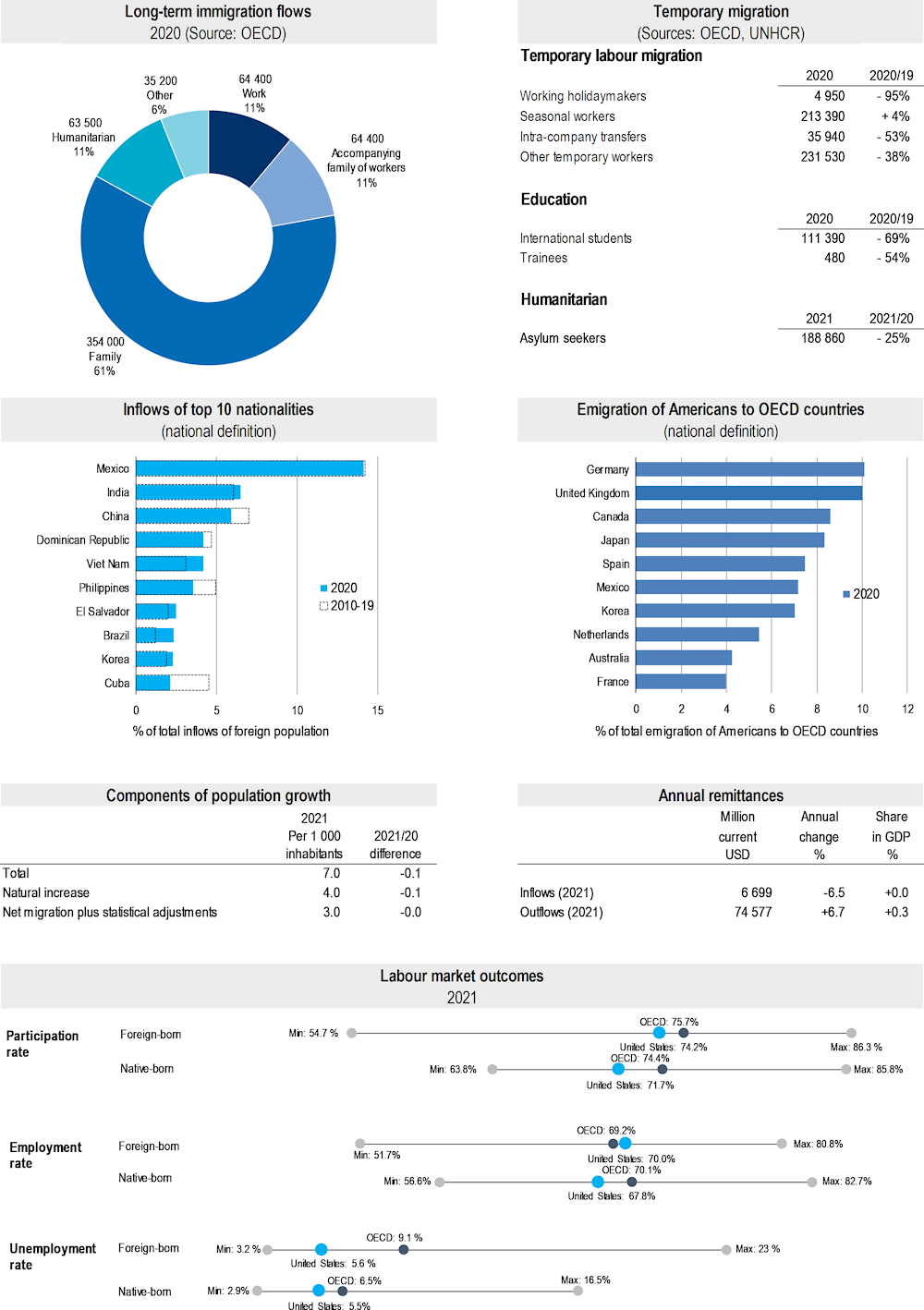In 2020, the United States received 582 000 new immigrants on a long-term or permanent basis (including changes of status), - 43.6% compared to 2019. This figure comprises 11.1% labour migrants, 71.9% family members (including accompanying family) and 10.9% humanitarian migrants. Around 111 000 permits were issued to tertiary-level international students and 486 000 to temporary and seasonal labour migrants.
Mexico, India and China were the top three nationalities of newcomers in 2020. Among the top 15 countries of origin, Afghanistan registered the strongest increase (1 200) and Mexico the largest decrease (‑55 000) in flows to the United States compared to the previous year.
In 2021, the number of first asylum applicants decreased by ‑24.7% to reach around 189 000. The majority of applicants came from Venezuela (27 000), Guatemala (23 000) and Honduras (20 000). The largest increase since 2020 concerned nationals of Colombia (7 400) and the largest decrease nationals of Guatemala (‑13 500). Of the 114 000 decisions taken in 2021, 18% were positive.
Increasing access and reducing barriers to the legal immigration system and naturalisation remained a priority for the U.S. Citizenship and Immigration Services (USCIS) in 2022. The agency took significant steps to address processing delays caused by COVID‑19 and other factors, including by waiving certain interview requirements and extending the validity of certain employment authorisation documents. USCIS also published a notice of proposed rulemaking addressing the public charge ground of inadmissibility.
In January 2022, the Department of Homeland Security (DHS) and the Department of State (DOS) announced policy initiatives to increase pathways for international STEM scholars, students, and researchers to study and work in the United States.
In 2022, DHS announced Temporary Protected Status (TPS) designations for nationals of Afghanistan, Ukraine, Cameroon, South Sudan and Sudan. DHS also continued to lead the Operation Allies Welcome initiative to support Afghan evacuees, and launched Uniting for Ukraine, committing to welcoming 100 000 Ukrainian refugees through a variety of legal channels.
DOS and DHS reinstated and expanded the Central American Minors (CAM) programme. On 29 March 2022, DHS and the Department of Justice published a final rule to enhance processing of asylum claims made by noncitizens subject to expedited removal.
Deferred action (which can confer employment authorisation) is offered for Special Immigrant Juveniles who cannot adjust to lawful permanent resident because a visa number is not available. Certain U visa (crime victims) holders are also now eligible for a four‑year, renewable grant of deferred action.
In December 2021, DHS and Department of Labour authorised an additional 20 000 H‑2B visas for temporary non-agricultural employment in the first half of FY 2022, with 6 500 reserved for nationals of Haiti, El Salvador, Guatemala, and Honduras They published another joint temporary final rule on 31 March 2022 to meet demand in the labour market, making an additional 35 000 H‑2B visas available for the second half of FY 2022, with 11 500 reserved for nationals of those countries.
In November 2021, DHS clarified that E (Treaty Traders and Investors) and L (Intracompany Transferee) accompanying spouses are employment-authorised based on valid non-immigrant visa status, as evidenced by an unexpired entry document (the Form I‑94), and do not need to apply for a employment authorisation document.
Certain policies are likely to be clarified in 2022 through judicial action. On 16 July 2021, a federal judge blocked DHS from adjudicating new applications under the Deferred Action for Childhood Arrivals (DACA) programme but granted temporary permission to continue processing of renewal requests for existing recipients. On 30 June 2022, the U.S. Supreme Court upheld the rescission of the Migrant Protection Protocols, which required certain migrants with pending asylum claims to be returned to Mexico to wait their immigration proceeding. The matter is now under review by the lower courts. Litigation also continues over the Title 42 public health order requiring the expulsion of asylum seekers during the COVID‑19 pandemic. The immigration enforcement priorities announced by DHS were vacated by a federal judge in June 2022.
For further information: www.whitehouse.gov/priorities | www.dhs.gov | www.uscis.gov/ | www.state.gov

